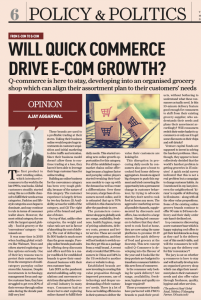I learned the most valuable lessons in retail by spending time in stores. A great way to enhance that learning is by attending conferences. I try to attend as many as I can afford (since I never seem to get any free invites!) and my most favourite events are the NRF Annual Convention and the World Retail Congress.
The NRF convention is called ‘Retail’s Big Show’, a term that started out as a nickname for the event and then just stuck. It’s usually four days long, open to everyone (at a price of course) and is held in New York in January. This year, Bill Clinton was the keynote speaker. He talked about the importance of retail in the current economic crisis. (He also wrote an article this week in London’s Financial Times on why capitalism, and not charity, will solve the world’s problems.)

In 2011, retail was one of the only industries that grew in America, growing double than the US economy, making up for almost 20% of its GDP and supporting 25% of its jobs. According to Clinton, by reinventing itself along with technology, retail could become a future business, a business that looks to the future for growth and helps all of us out of the current economic situation.
Another exciting aspect of the NRF is that new technologies are unveiled: a way to monetise Facebook ‘likes’, apparel selection using gestures, a mobile-based POS, location-based mobile marketing, and a new shift from customer relationship management through customer performance management to track customer lifetime value. There are also new mobile- and kiosk-based solutions being experimented with, to reduce the cost of payment.
In India, retail conventions are trying hard to match their global counterparts in most ways. The Retail Leadership Summit 2012, held almost immediately after the NRF, had a range of international speakers to share global practices, values and strategies. With the FDI in retail in sight, most of them also had a vision for the Indian market.
Today, there are large investments being made in the retail sector by top industrial houses. All of them want to be part of this exciting space. Simon Susman of Woolworths, South Africa had a secret to share. It doesn’t matter how much funds a retailer or a retail chain has access to; in order to be successful and profitable, you need to remain a shopkeeper at all levels. The core values of a shopkeeper are the key to success for every size and format of retail business.
Companies that are able to run their businesses with the same attitude will survive and succeed. And India, a country full of shopkeepers, holds more than just a promise for that! Dr Gordon Campbell of SPAR International shared SPAR values and spoke about how SPAR modifies their business offerings in different markets, including India, to be successful and customer friendly. It was interesting to know how SPAR engages with local partners in different countries and builds profitable businesses in a unique way.
In India, this could mean opportunities for local shopkeepers to form retail cooperatives to partner and profit. SPAR business models revolve around store-level profitability within six months and this was a big surprise to major Indian brands since lead time for store-level profitability here is more than 12 months.
To me, the biggest learning experience was the address by Ireena Vittal, partner, McKinsey. Ireena drew a very simple view of Indian retail market till 2020 in the wake of different growth rate scenarios. In the unlikely possibility of growth rate limiting to 6.5% for the rest of the decade, Indian retail will continue to grow at more than 10%.
Most interesting were the examples she used to illustrate changes in consumerism in India. Although we are a country full of sharp consumers, with more disposable income the term ‘value-for-money’ is acquiring a new meaning. Last Diwali saw a rise in sales of Ferrero Rocher (premium chocolates) over mithai (traditional Indian sweets). With an FR box retailing at `275, both chocolates and mithai were available in the same price bracket. But the gold ribbon around a box of FR made it almost a natural part of our festive season.
And then, there was the instance Ireena cited of a Gujarati husband who found the most value-for-money anniversary present for his wife in a LVMH handbag! These luxury bags can be found at some select outlets with a start price of `35,000, or the same cost as of an iPad or high-end phone, both close seconds as options for the gift. Jewellery, however, came in last.
Anything that would be appreciated enough would cost more than 1 lakh. A recent flavour of these conventions has been green initiatives. Food retailers have started charging for the shopping bags to reduce consumption of plastics. But I am not sure how practical that is.
One way to be eco-friendly is to work with NGOs and create jute or cloth bags that could be given to loyal customers in exchange for loyalty points or during a big ticket purchase. Consumers can then be encouraged to bring back these bags on each shopping occasion to earn further discounts or additional loyalty benefits, generating brand loyalty and creating a closer engagement between them.
The customer has been a recurring theme at these conventions too. And the commitment shown by retailers across board towards their consumers is a very encouraging and big hope for modern retail in India.
From a series of articles commissioned by DNA (Money) dated 25 January 2012.



